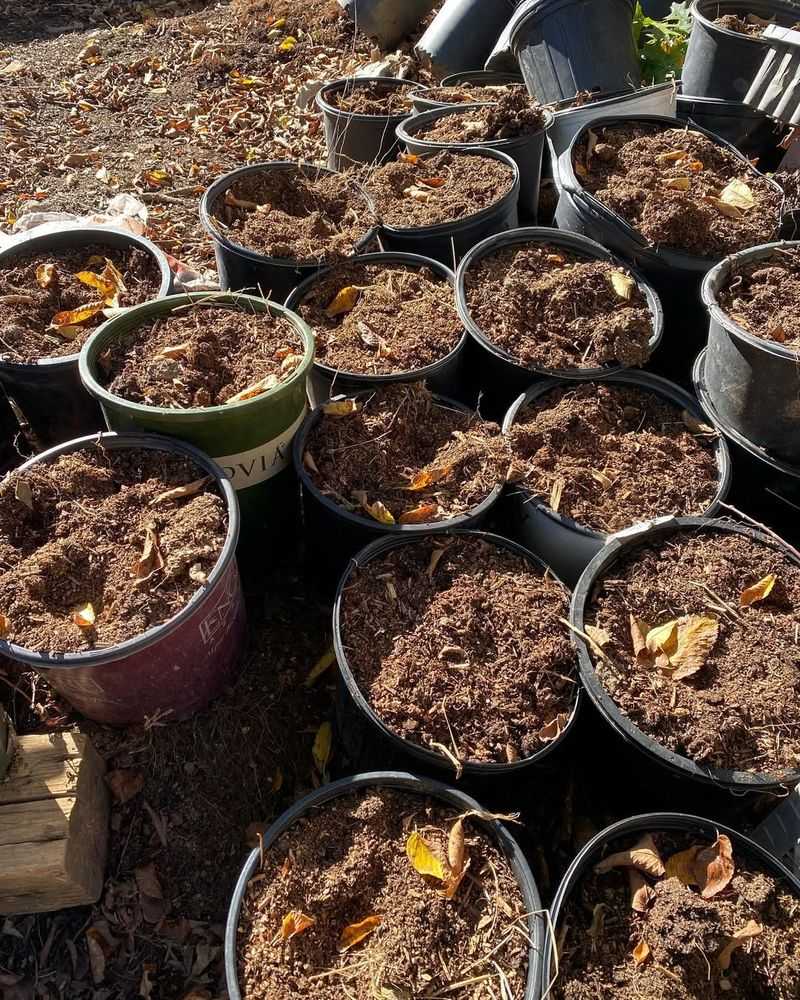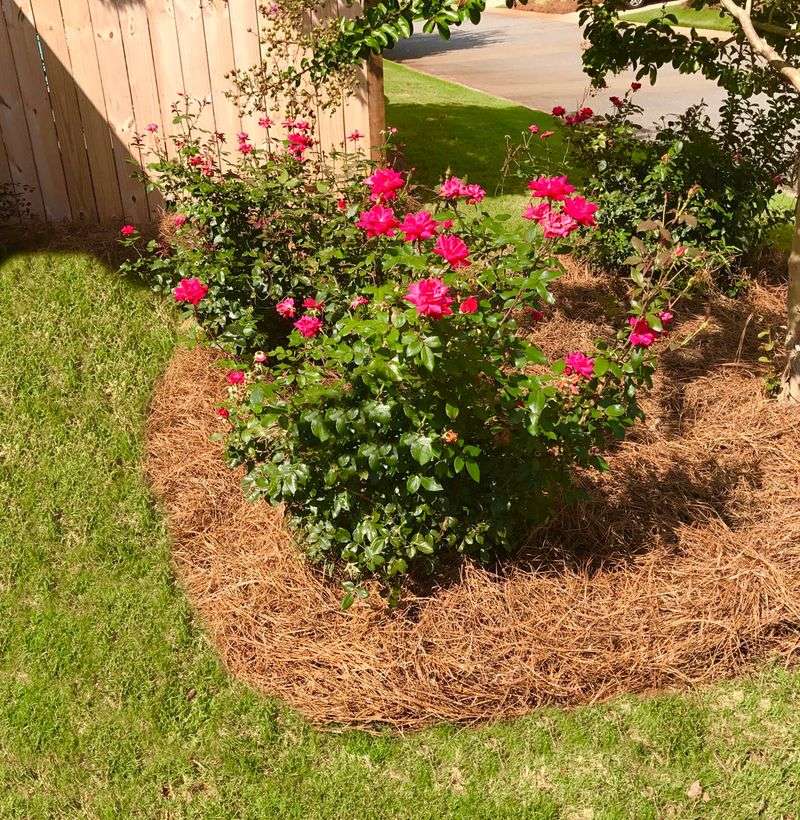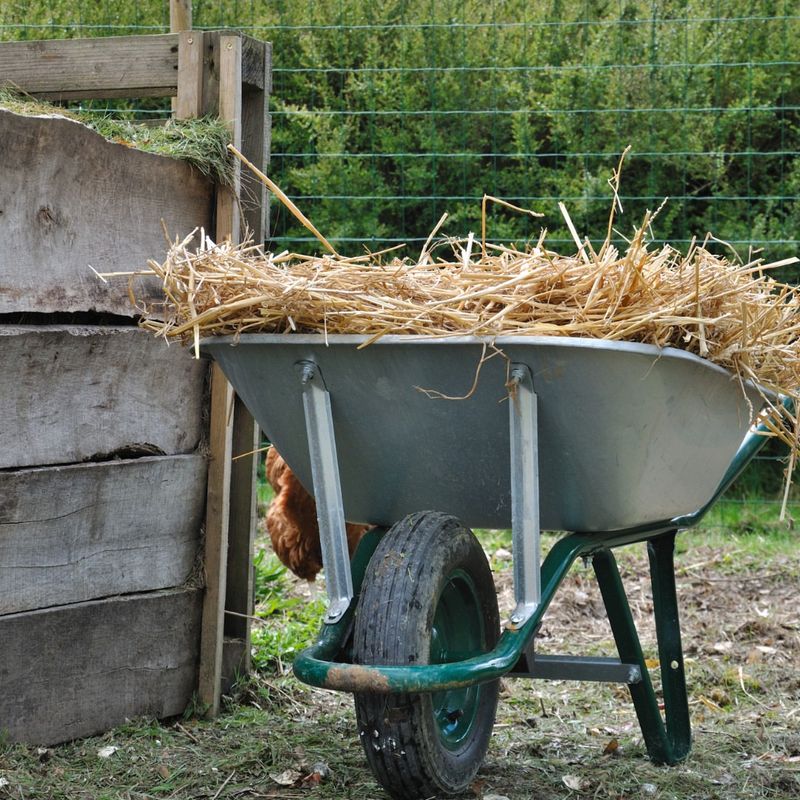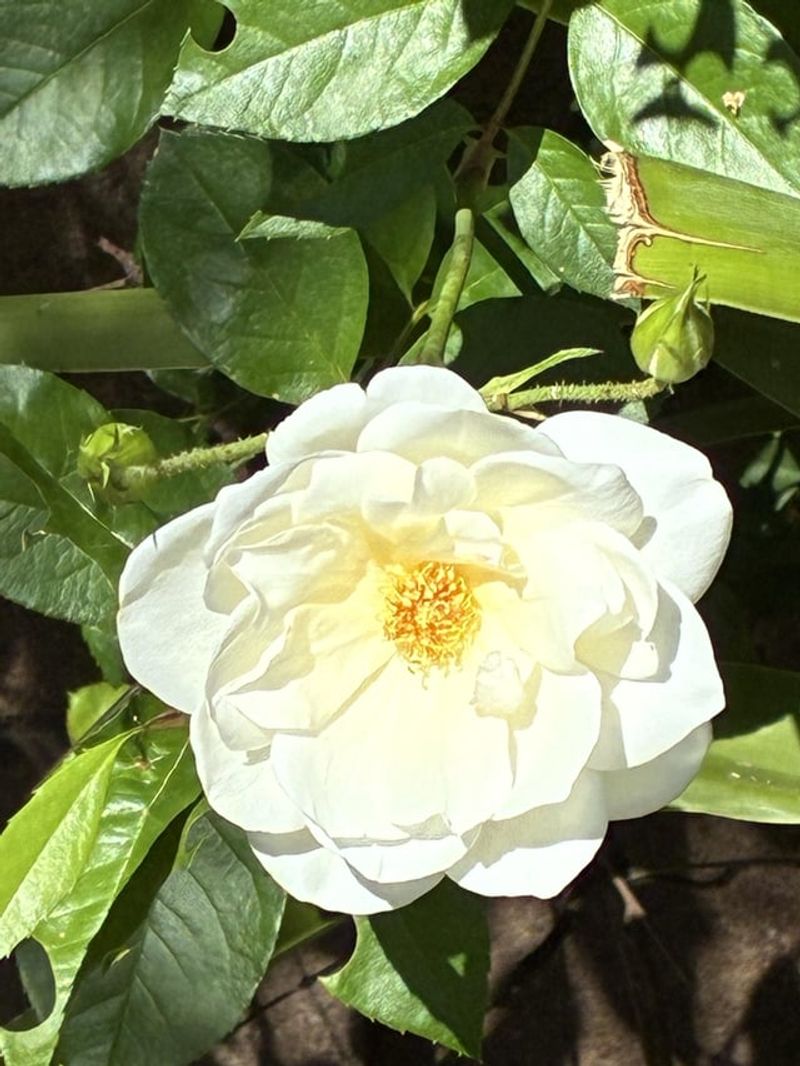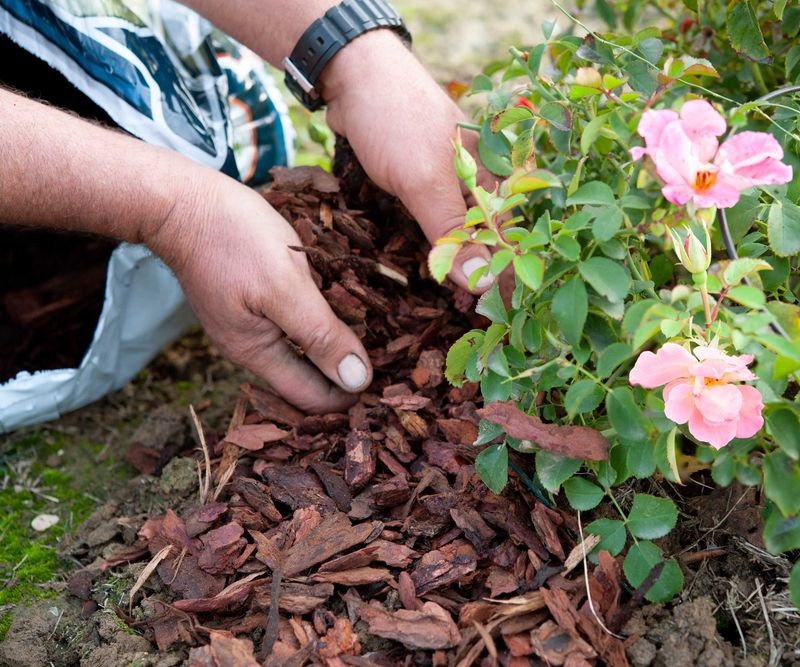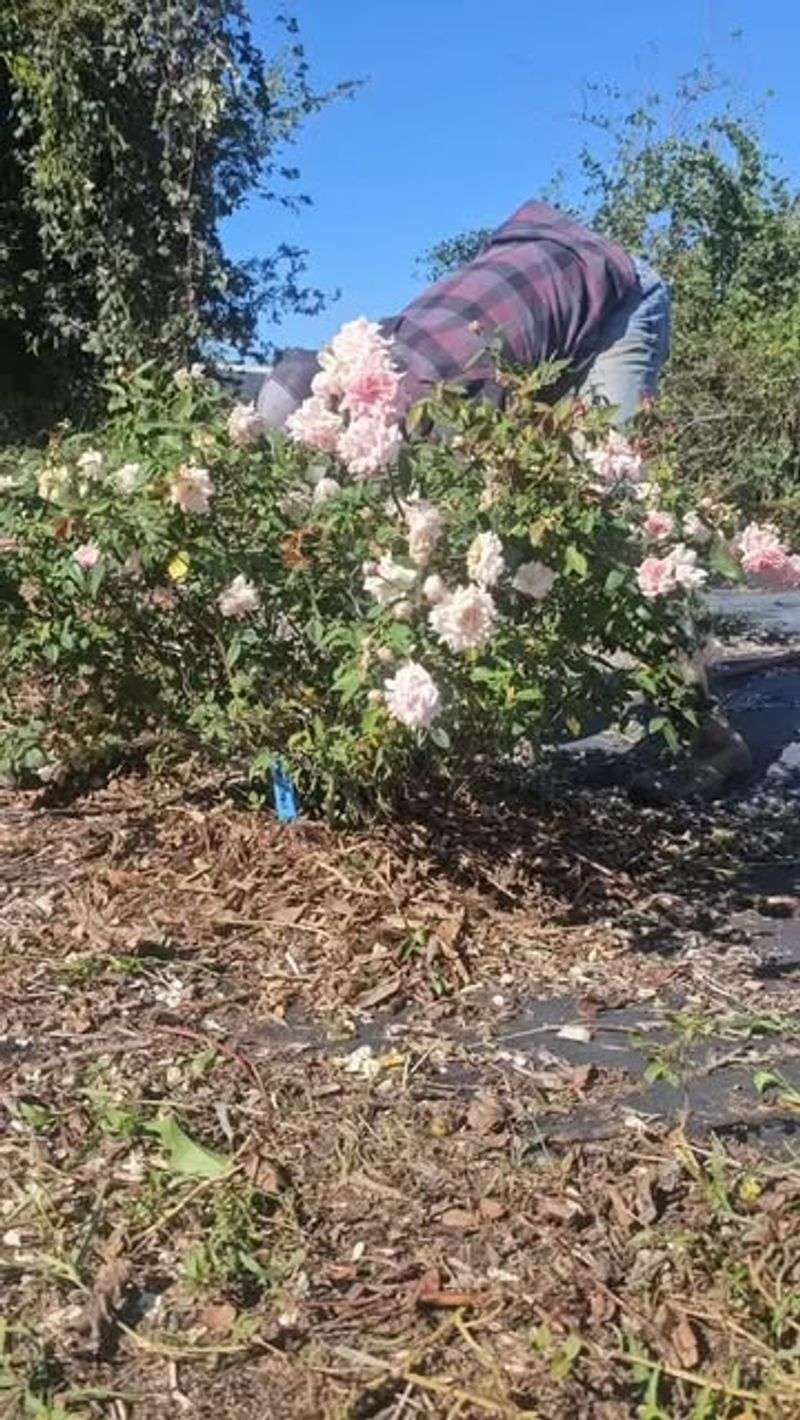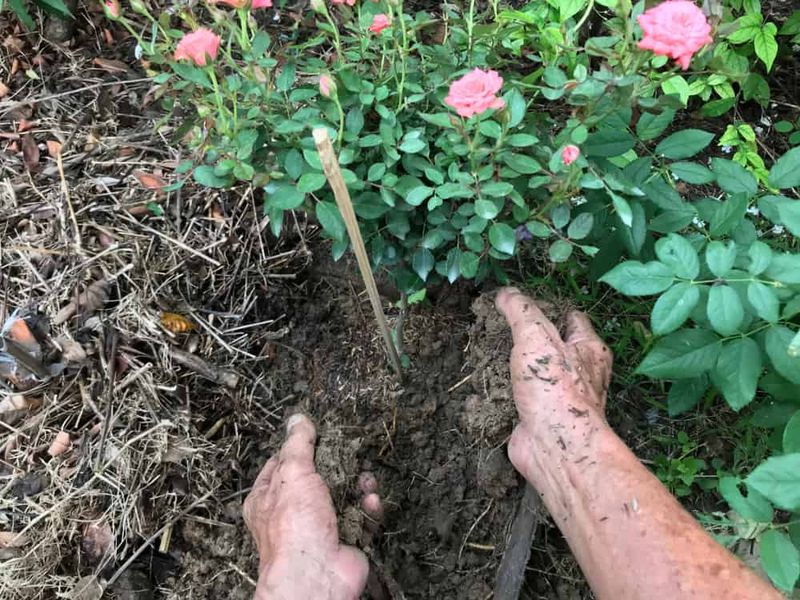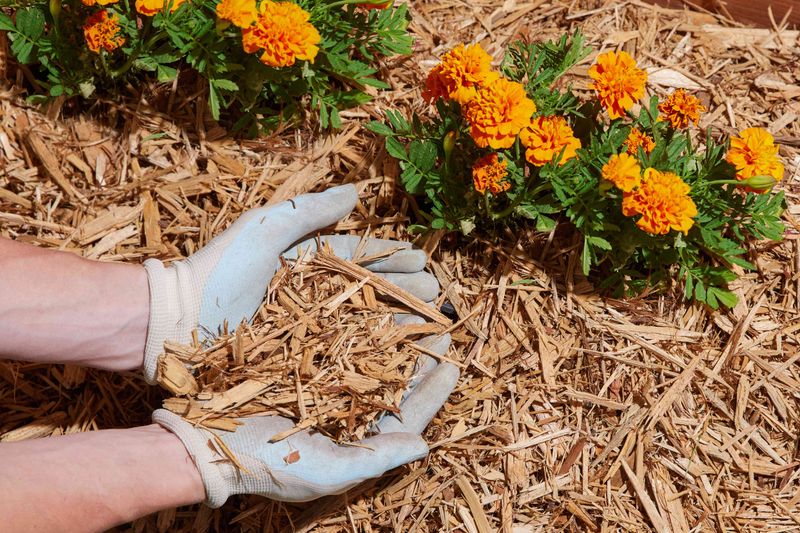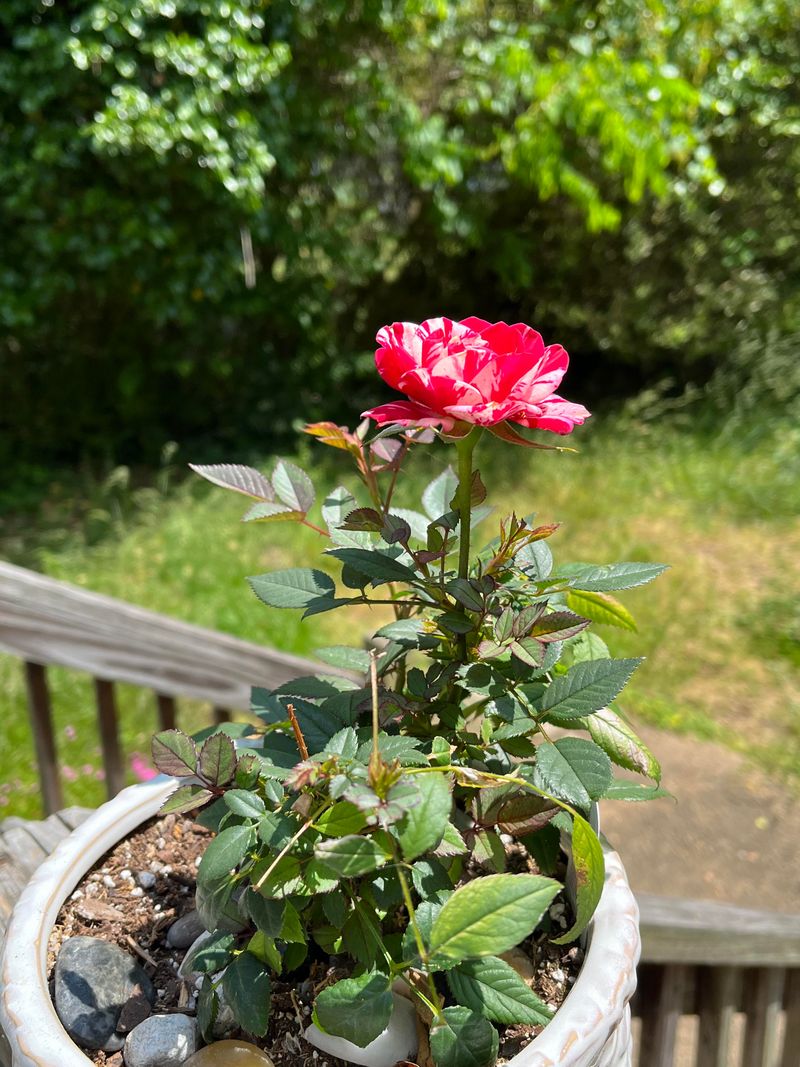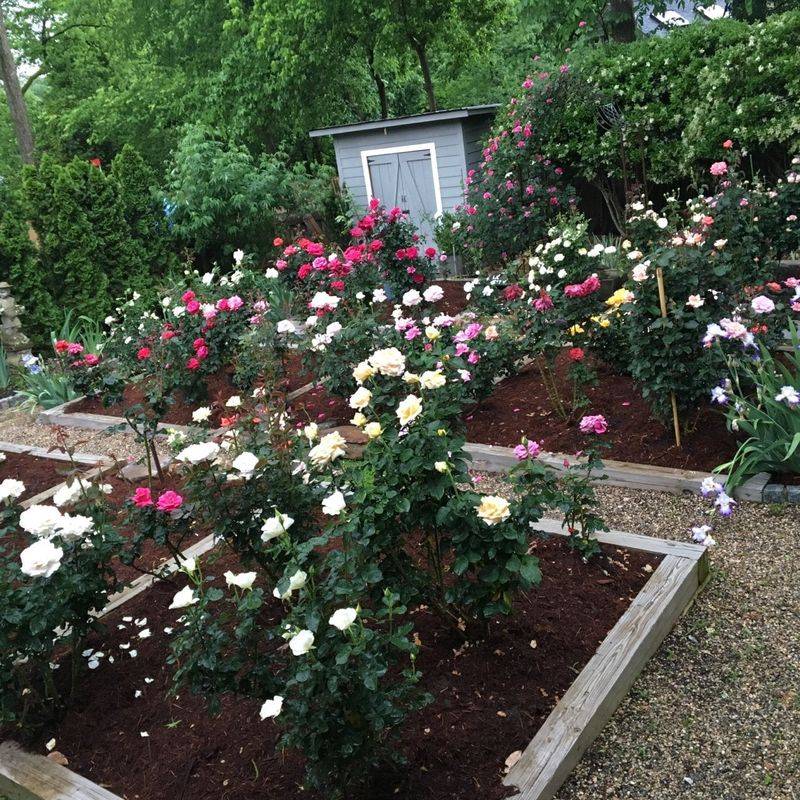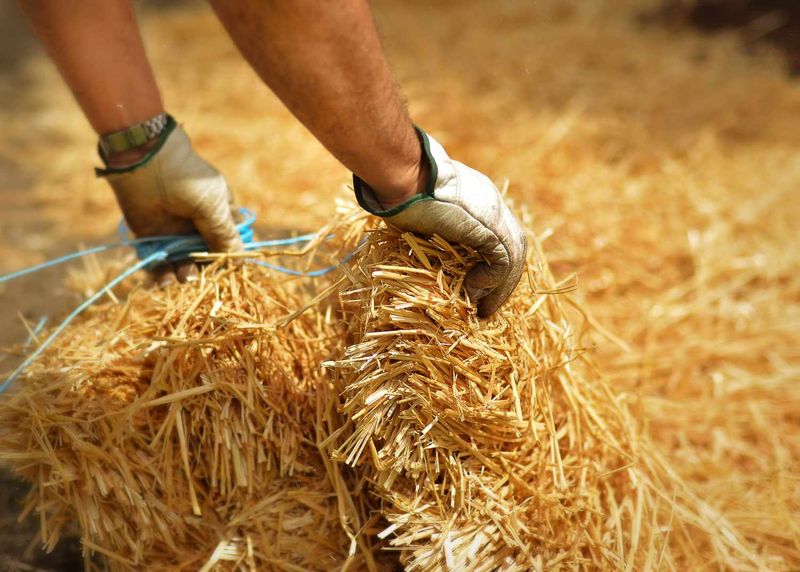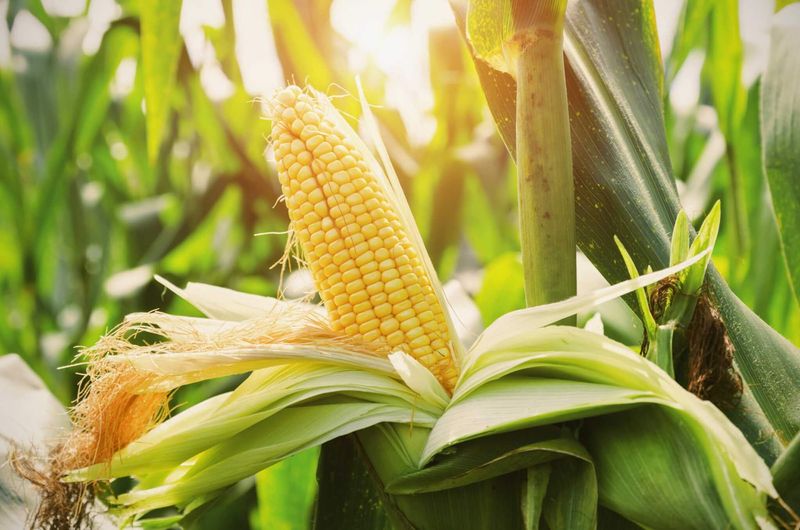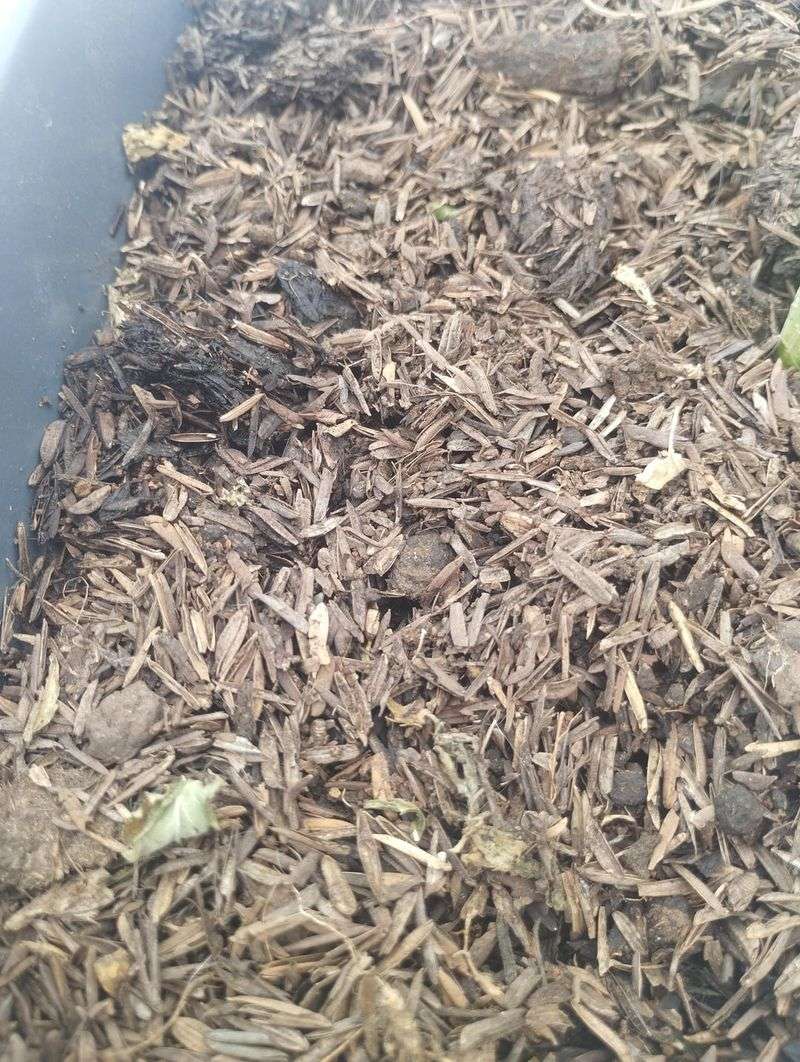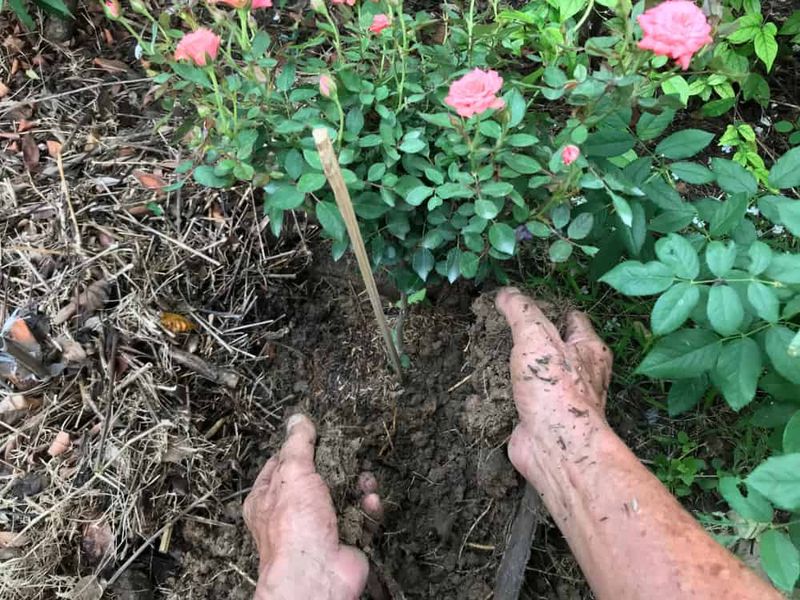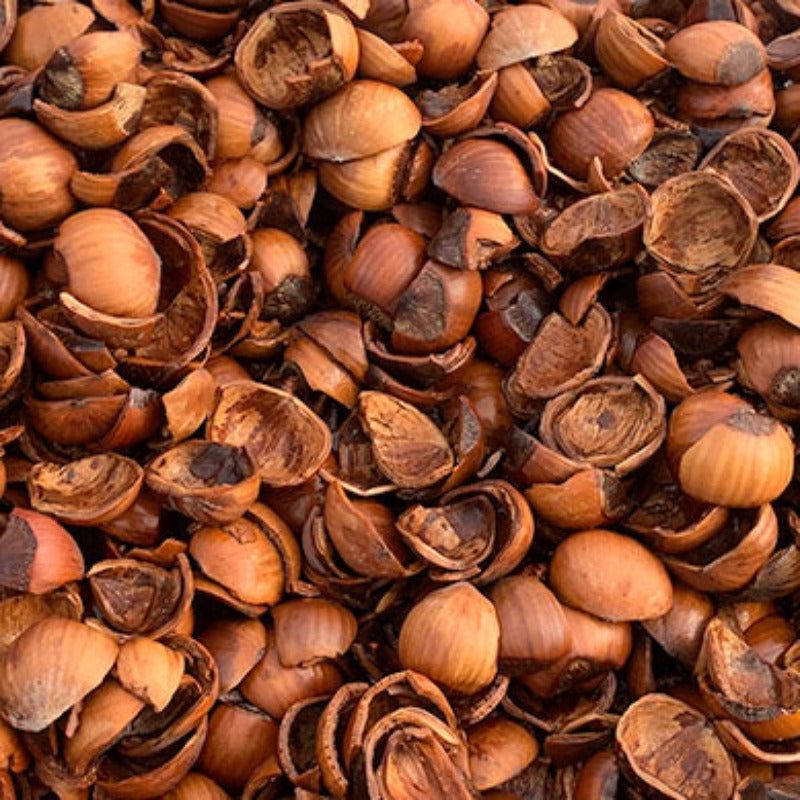Mulch does more than just look good—it’s a secret weapon for thriving roses. The right natural mulch locks in moisture, blocks weeds, feeds the soil, and keeps your rose beds blooming beautifully.
From compost to cocoa hulls, these 17 natural mulch options will keep your roses happy, healthy, and full of color all season long.
1. Shredded Leaves
Fallen autumn leaves make excellent free mulch for your rose garden. Simply run your lawnmower over them to create a finer texture that won’t mat down or blow away.
The leaves gradually decompose, adding valuable organic matter to the soil while protecting your roses’ roots from temperature extremes. Many gardeners notice fewer disease problems when using leaf mulch compared to other options.
Maple and oak leaves work particularly well, breaking down at just the right pace to nourish roses throughout the growing season.
2. Composted Manure
Well-aged manure provides a nutrient-rich blanket for hungry rose plants. Make sure it’s fully composted—fresh manure can burn tender roots and stems with its high nitrogen content.
Roses particularly love horse, cow, or sheep manure that’s been properly aged for at least six months. The dark, crumbly texture improves soil structure while slowly releasing nutrients.
Apply a 2-inch layer in early spring, keeping it several inches away from the base of the plant to prevent crown rot issues.
3. Pine Needles
Pine needle mulch creates a light, airy layer that allows water to easily reach rose roots. The needles interlock naturally, staying put even in windy conditions or on sloped areas.
Contrary to popular belief, pine needles won’t significantly acidify your soil. They break down very slowly, making them a long-lasting option that needs less frequent replenishing than other organic mulches.
The distinctive reddish-brown color provides an attractive contrast against green foliage and colorful blooms in your rose bed.
4. Cocoa Shell Hulls
Rich chocolate-brown cocoa hulls add a touch of luxury to your rose garden. The pleasant chocolate scent makes garden work more enjoyable, though it fades after a few days.
These lightweight shells interlock to form a protective barrier that effectively blocks weeds while allowing water to penetrate easily. They’re particularly good for formal rose gardens due to their uniform appearance and neat finish.
Important safety note: cocoa hulls contain theobromine, which is toxic to dogs if ingested in large quantities, so avoid this option if pets frequent your garden.
5. Straw or Salt Hay
Lightweight and affordable, straw creates excellent winter protection for rose beds. It traps air pockets that insulate roots from freezing temperatures, making it perfect for cold-climate gardeners.
Salt hay (harvested from coastal marshes) offers similar benefits but resists decomposition longer than regular straw. Both options allow good air circulation, reducing fungal problems that plague roses.
Apply a thicker layer (4-6 inches) in late fall after the first frost, then remove most of it in spring, leaving a thinner layer for summer moisture retention.
6. Grass Clippings
Free and readily available, grass clippings make practical mulch for budget-conscious rose gardeners. Allow clippings to dry slightly before application to prevent matting and smelly decomposition.
Apply in thin layers (no more than 1 inch at a time) to prevent the formation of a water-repelling mat. Fresh clippings deliver a quick nitrogen boost that roses appreciate during their heavy blooming periods.
Only use clippings from lawns that haven’t been treated with herbicides or pesticides, as chemical residues can harm your precious roses.
7. Shredded Hardwood Bark
Long-lasting and attractive, shredded hardwood bark creates a polished look in rose gardens. The irregular pieces interlock to stay in place on slopes and resist being displaced by heavy rain.
Hardwood bark breaks down slowly, providing a steady supply of nutrients while improving soil structure. Many rose enthusiasts appreciate how the dark color makes flower colors appear more vibrant by contrast.
Aged hardwood mulch is preferable to fresh, as the decomposition process won’t compete with your roses for nitrogen in the soil.
8. Compost
Homemade compost offers the perfect balance of soil protection and nutrition for roses. The dark, crumbly texture improves drainage in clay soils and water retention in sandy soils.
Finished compost introduces beneficial microorganisms that create a healthier root environment. Roses mulched with compost often show increased disease resistance and more prolific blooming compared to unmulched plants.
Apply a 2-3 inch layer in spring, refreshing as needed throughout the growing season as the compost gradually incorporates into the soil.
9. Alfalfa Meal or Pellets
Alfalfa provides a double benefit as both mulch and fertilizer for roses. It contains triacontanol, a natural growth stimulant that can increase flower production and overall plant vigor.
The pellets expand when wet, creating a protective layer that gradually breaks down. Many experienced rose growers swear by alfalfa’s ability to produce larger, more colorful blooms and stronger stems.
Apply a 1-inch layer in early spring when new growth begins, working it lightly into the soil surface around established plants.
10. Mushroom Compost
Spent mushroom substrate—the material left after mushroom farming—creates wonderful rose mulch. It’s typically a mix of composted manure, straw, and other organic materials that mushrooms have already partially broken down.
Roses love the slightly alkaline pH and rich nutrient profile of mushroom compost. The fine texture retains moisture exceptionally well while still allowing good air circulation to the root zone.
Fresh mushroom compost can be high in soluble salts, so it’s best to age it for a few months before application or mix it with other mulch materials.
11. Coffee Grounds
Used coffee grounds offer an ingenious way to recycle kitchen waste while benefiting your roses. The fine texture creates a dense barrier against weeds while slowly releasing nitrogen as they decompose.
Many local coffee shops will give away used grounds for free. Mix them with other mulch materials to prevent them from forming a water-repellent crust when applied alone.
Coffee grounds can slightly acidify the soil over time, which works well for roses growing in alkaline conditions. The dark color also absorbs heat, warming soil earlier in spring.
12. Buckwheat Hulls
Buckwheat hulls create a lightweight, attractive mulch that resembles tiny wooden chips. They interlock naturally to form a weed-suppressing mat while still allowing water to penetrate easily to rose roots.
Unlike some heavier mulches, buckwheat hulls won’t compact over time, maintaining good soil aeration. The medium-brown color provides a neutral backdrop that makes rose colors pop visually in the garden.
Though more expensive than some options, buckwheat hulls decompose slowly, often lasting two seasons before needing replacement.
13. Chopped Straw
Machine-chopped straw offers better garden performance than whole straw bales. The shorter pieces stay in place better while providing the same excellent insulation properties for rose roots.
Unlike whole straw, chopped straw decomposes more quickly, adding organic matter to the soil. It creates a light-colored mulch that reflects heat, keeping root zones cooler during summer heat waves.
Look for certified weed-free straw to avoid introducing unwanted seeds into your carefully tended rose beds.
14. Corncobs (Crushed)
Crushed corncobs create an unusual but effective mulch for rose gardens. The rough texture discourages slugs and snails that might damage tender new growth on your roses.
As they break down, corncobs add valuable organic matter to the soil. Their neutral pH works well with roses’ preference for slightly acidic to neutral growing conditions.
Farm supply stores often sell crushed corncobs as animal bedding—this cleaned version makes ideal garden mulch. Apply a 2-3 inch layer, refreshing annually as the material gradually decomposes.
15. Rice Hulls
Rice hulls create a unique, lightweight mulch that’s particularly effective in container-grown roses. The small, boat-shaped particles interlock to form a protective layer while allowing excellent water penetration.
Unlike wood mulches, rice hulls won’t rob nitrogen from the soil as they decompose. They’re pH neutral and won’t affect soil chemistry, making them suitable for all rose varieties.
The light color reflects sunlight, helping keep soil temperatures moderate during hot weather—a real benefit for roses that struggle in extreme heat.
16. Seaweed
Coastal gardeners have long used seaweed as premium rose mulch. Rich in micronutrients and natural growth hormones, seaweed provides trace elements often missing from inland soils.
Rinse collected seaweed with fresh water to remove excess salt before application. As it breaks down, seaweed releases alginic acid, which improves soil structure and water retention around rose roots.
Apply as a thin layer (1-2 inches) in spring, then top with another mulch type if desired. The quick decomposition means more frequent application but excellent nutritional benefits.
17. Nut Shells
Crushed walnut, pecan, or hazelnut shells create long-lasting mulch with excellent drainage properties. Their slow decomposition rate means less frequent replacement, saving time and effort in rose bed maintenance.
The shells’ rough texture discourages cats from using rose beds as litter boxes—a common garden complaint. Their dark color absorbs heat, beneficial for roses in cooler climates by extending the growing season.
Avoid using black walnut shells, as they contain juglone, which can inhibit rose growth. Other nut varieties pose no such problems.



